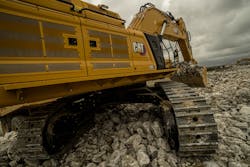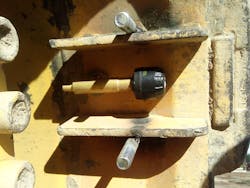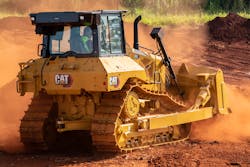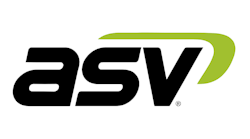An army might run on its stomach, but industry runs on tires and tracks! Consider the contribution of these unsung heroes—from the invention of the wheel to today’s massive heavy machinery—nothing gets done unless tires are involved.
Some of the latest success stories as shared by JP Moncada, Brand Manager of Bridgestone off-road division, highlight their Versabuilt Radial tires lineup.
“This range is used on construction sites mainly in loaders, graders, articulated dump trucks, and scrapers from the 24-inch to 35-inch applications, and are offered in three different tread patterns including a mud-ready All-Traction, a hearty Deep Tread, and a versatile All-Purpose tire," Moncada explains.
He adds that these tires are built with steel casings and SideArmor sidewalls that in this demanding work help protect against cuts and punctures by deflecting stones and debris. “This helps our customers get more wear life from each tire.”
Citing the last decade as “so transformational for our construction tire business, we were able to expand the production of our tire plant in Bloomington, IL, to include 29, 33, and 35 inch OTR tires.”
Moncada says that since every job site has its own unique terrain and challenges, “Contractors look for the right tire application for the right job as this is definitely not a one-size-fits-all scenario.
“When you’re on the site, the goal is to maximize performance and traction, maintain efficiency, improve productivity, and ultimately, protect profit margins. We like to say ‘equipment in motion is equipment making money’ so it’s key to making sure you have the right tire for that equipment.”
The menu of Bridgestone tires has more than 60 different patterns for specific construction needs, “and we see ourselves as more of a partner for completing each job, rather than as just a tiremaker."
With the largest network of dealers in the country, Moncada says each dealer is an expert in helping to find the right solution for each job site. "Mud? Rocks? Sand? We have an OTR tire for just about any terrain you can imagine. We’re ready for the moon when the first quarry opens there. And with the right tires or tracks, contractors should be able to improve efficiency and productivity, extend the life cycle of their purchase, and lower their operational costs.
He adds that looking beyond just traction, durability, and tread patterns, Bridgestone has also developed an expanding list of Mobility Solutions. “These are integral to helping maximize the useful life of each tire on the job site. It’s crucial to help customers lower the cost of ownership while improving productivity, so we have recently launched PressureStat.
"This is a system that gives real-time access to important tire data so if a problem is detected it can be addressed right away to avert downtimes, and avert potential safety issues from faulty tire issues like low pressure, or undetected damage.
“We also have TreadStat which is our tire and rim management and budgeting solution that forecasts tire needs and tracks performance. When you pair these assets with Bridgestone’s world-class tires, these tools can be used in tandem to monitor each tire on a job site. Moreover, they allow you to preempt issues that could result in unwanted downtime, and keep equipment moving to complete the job safely and on schedule."
While tires are an essential and unavoidable investment Moncada says it is one that contractors must carefully weigh to ensure they are getting the best value not just for their dollar, but for the job of today and tomorrow.
He points out, "When contractors shop for tires, they have a lot to choose from. Yet in that process, it is really important to find the tire supplier who is your partner. Not only do they help you choose the right tread pattern that meets the needs of your projects, but that tire is backed by a network to support you and your job no matter where it is.
“Our OTR customers depend on us and we are constantly developing innovations and mobility solutions so you can get the job done on budget and on time. Your tires are the last thing you need to be worried about.”
A Simple Sketch Reaches the Cloud
The story of the PressurePro tire pressure monitoring company might be likened to that fairytale legend of a company whose good idea starts with a sketch on a cocktail napkin.
"Actually, that is exactly how it happened," says President and CEO Jason Zaroor, who speaks to the founding of his family-owned business.
"In 1991 a guy who was a truck driver came to my father with an idea sketched on a napkin. He envisioned then that this was the answer to simplifying an age-old problem, but it would require a product that was so unique it would have to be created from the ground up."
Nothing like it had ever existed, Zaroor says, "but my father Philip Zaroor was anything but fainthearted, and he took on this idea to bring it to fruition."
Fast-forwarding to today, Zaroor adds that the genesis of the tire pressure monitoring system, now known as TPMS, originated with that drawing and the subsequent innovations that transpired from building on the first tire monitoring products.
"We had first focused on the RV market, since RVs are always having tire problems and the RV owners are typically in a position financially to invest in this, they were the perfect customer."
But then in 2007, a mandate was passed for every passenger car that rolled out of the factory to be equipped with a tire pressure monitoring function.
"But the regulation governing passengers cars did not mandate TPMS in anything bigger than a car," Zaroor says.
He says their system is similar to the monitoring units found on a passenger car, "but on steroids."
Zaroor explains how it works and the value it brings to the construction and industrial tire market.
"Our sensor, which is really the foundation and brain of our entire solution, simply fits on your valve stem.” He says it comes in two sizes to accommodate standard or large bore valve stems and it replaces the regular cap.
“The sensor is fabricated from a brass fitting encased in HDP (high-density polyethylene) and encased in solid epoxy inside so the whole thing is completely waterproof and durable enough to withstand all the extremes our solution operates in.”
Zaroor explains that every seven seconds, the tire is checked by this monitoring/sending unit and they "are still using an RFI 433 and 92MG frequency, which was the first frequency we used and it is still very effective."
As soon as the sensor is installed to a stem, they begin to continuously sample tire performance and then report that data to a receiver box in the truck.
"From there, our receivers can display the information directly to our drivers, and can also tie into connected solutions to report to our cloud-based tire management system—Pressure ProConnect.”
It's not just detecting any change in tire pressure, he says; it is immediately reporting information to the driver.
“Plus, we are simultaneously sending these alerts to your fleet controllers or maintenance managers. The system delivers unmatched visibility and understanding of tire performance across your entire fleet.”
With sensors on vehicles in 62 countries working around the clock, Zaroor says that PressurePro is now serving multiple markets from RVs to commercial trucking, mining, and more, "but our core competency is our ability to easily and reliably integrate our technology with existing OEM platforms.
"We currently do this with partners such as Case New Holland, Hitachi, and Caterpillar. With many of our customers, you won't even notice the PressurePro equipment; other than the device on the tire, we are integrated seamlessly into factor displays and more."
The benefits to users, he adds, are arming drivers and fleet controllers with crucial information to add safety, extend tire life, reduce downtime, and more.
“But perhaps the biggest benefit of our technology is that it takes the responsibility of tire monitoring off the driver or machine operator. Our full hardware and software ecosystem, which by the way, is designed and built entirely in the US, instantly delivers your tire performance data across your maintenance and control staff.
“Your fleet manager can then instantly know that truck 180, for example, has a driver’s steer that is low on pressure, so it can be flagged for service. Or even better, managers can start to see a pattern in tire trends or driver behavior. This helps them to begin moving the maintenance plan to predict issues instead of reacting to them. So, it's not just a measuring device, but an entire fleet management asset."
Zaroor points out that operators already have modems for fuel and other operating system levels, but with thousands of accidents caused by under-inflated tires, "This is inarguably an essential monitoring system for an industry that faces risk every day.
"Right now, TPMS awareness is growing rapidly in waste and mining; these arenas are becoming a big market for us. Municipalities are spending thousands every fiscal quarter for new truck tires, and they are practically immune to this line item budget as a necessity. But if you can keep on top of tire truck pressure, you can help that situation."
Zaroor emphasizes that PressurePro is still the "Cadillac tire monitoring technology of the market."
"Our mission is to give you the best, real-time, remote tire pressure system you could ever have. But there's no resting on laurels here as we constantly look to new technologies and opportunities where we can improve performance and save you money."
The Endless Chain Keeps Improving
Incredibly, it's been nearly 100 years since the first commercially available, continuous tracked vehicles were introduced to the market and eagerly welcomed by the land moving workforce.
As the first branded product, Caterpillar launched and has led the market; according to Tim Nunne, senior market professional for Caterpillar undercarriages, innovations never stop improving the endless loop chain vehicle.
“For the past 18 months, we have introduced new designs that will increase undercarriage life in many different applications,” Nunne says.
One good example is the new HDXL link assemblies for D8-D11 machines that use a technology where a new curved rail surface puts our wear material on the surface where it delivers the largest wear life increase. To assure the customers that all the additional steel is an essential asset, we’ve added a newly developed bushing end-coating that not only increases seal but expands the bushing diameter by 40% to compatibly ensure that the bushing wear life matches up with the link wear life.”
Nunne adds that these new link assemblies are also partnered up with larger diameter rollers so the entire undercarriage system can run longer and at a lower cost per hour.
For the Large Excavators, he says that Caterpillar has introduced positive pin retention for their 345–395 machines.
"Large Excavators routinely put high loads on the undercarriage components," Nunne explains. So the pin and link must be mechanically locked together.
"To address this on these large units, we've introduced a new style of pin retention which increases undercarriage life in the most rugged applications and also increases the strength of these links to handle the higher break out forces of today's excavator line."
For Medium Track Type Tractors, Nunne says they’ve introduced Cat Abrasion, designed for high abrasion applications, that “changes the way an undercarriage works and wears."
“We use a rotating bushing technology and relieved treat idlers that no longer contact the link wear surface, but one of the most important updates for Cat Abrasion customers is our latest in seal and coating technologies that can significantly extend track joint life in high abrasion applications. There is a new line of undercarriage for moderate- to high-impact conditions, and we also have a new HDXL option for this size class of machines.
With the high-impact resistance, pin retention technology, and a link designed with additional steel added to high-stress areas, "customers can expect longer life and an economical system.”
In today's world, the once rudimentary endless chain has been tremendously modified to handle adverse terrain like mud, loose ground, and uneven or hilly conditions. “No question we have come a long way from those first days,” Nunne says, but adds that pin technologies are really what have changed their service.
“The way these work is the link assemblies use a pin retention system to lock the pin and link together, and this maintains joint integrity even in the toughest of applications.” Nunne says this configuration allows machines to run the undercarriage for longer hours and maintain the oil in the track joint.
“Nonetheless, under the highest of impact conditions just having positive pin retention is still not enough to assure oil retention. So we created a proprietary bushing end coating technology that increases that seal life and greatly reduces grooving on the end of the bushing. It’s the best of both worlds when pin retention and coating technologies work in tandem as it helps today's customers to achieve long link life by maintaining oil in the track joints, even in the toughest conditions," Nunne affirms.
When customers are looking to buy and/or replace their undercarriage, he advises “to evaluate a number of considerations while choosing features."
“For example, what type of application dominates the business, what are underfoot conditions, how generous is your budget? Your uses and ownership tenure are all part of the decision," Nunne advises.
“In today’s world, no single one type of undercarriage meets all customer needs, but you can get what you want and need from our Caterpillar portfolio of options.
“The Cat Portfolio of Undercarriage includes General Duty Undercarriage, Heavy Duty, HDXL, and Cat Abrasion for the Track-Type Tractors. Having multiple options allows customers to select the undercarriage that best meets their needs."
When making this kind of investment, he stresses that “you need to be informed on all aspects that affect your performance, your budget, ownerships, and costs per hour.
"An informed decision upfront will ultimately result in giving you longer wear life, reduced downtime, and lower costs."
Taking a Bite Out of Mud
The scenario is familiar. A challenging job on a slope suffering the effects of erosion: uneven, rocky, and you’re already behind schedule. Then a sudden downpour turns that terrain into a muddy mess. But Matt Miller, tire technology manager of Titan International research and development, says fear not, “We’ve got the answer to keep you on the job.”
"This kind of extreme scenario with muddy, uneven terrain requires a tire that can bite into the mess and keep you going."
He says the company has recently developed an industry-unique hybrid loader tire to handle the worst of those jobs.
“Our new H/K 458 is an E-4/L-4 dual-rated bias tire and gives you aggressive traction for the most daunting conditions. The tread combines the design attributes of a forestry tire plus a specialty loader tire and an ATV tire in an all-in-one design. What this does is give you a deep-tread, directional pattern and an aggressive traction function. At the same time, its steel-belted radial construction and specialty compounding give you great longevity and puncture resistance.”
Miller says this tire is available in two sizes for medium-size loaders at 20.5–25 inches and 23.5–25 inches and hit the market in February 2021.
He also adds other recommendations for contractors to consider when tackling these conditions.
"For a steep muddy project, you need a deep tread depth and a higher void to lug ratio. The tread design, however, will be different depending on the type of machine you are operating.
“For example, if you are on a skid-steer you’d want to go with a design that not only gives you that deep tread but one that has a bar lug design rather than a button lug (turf tread) or a diamond lug configuration.”
One of the ideal choices, Miller says, would be their Titan Ultimate that offers almost twice a tread depth of a conventional skid-steer tire.
“Plus, this has a stepped lug edge design and this feature gives you long life and excellent traction.”
With larger equipment like loaders and articulated dump trucks, Miller says diamond lug patterns are the most common but also very versatile. He advises that for traction and stability on loose and uneven terrain but also good roadability and long life on harder surfaces, contractors should consider the Titan STL3.
"This choice has an aggressive tread design but also a full-width shoulder lug and we've recently expanded our line to include a seventh size—the 875/65R29 for articulated dump trucks, wheel loaders, and scrapers."
As this tire is a dual-rated tire (E-3L-3), Miller says it can run in earthmoving and hauling applications or on loaders performing dig and dump.
He adds that choosing that right tire has benefits beyond fulfilling the demands of a respective job project.
“Making sure you get the right tire that is going to last longest in its designated work capacity is great, but you also need to go beyond tire size. It’s all about ratings, tread compound, and more. To help you, Titan has developed a simple White Paper guide called 'Tire Codes 101.'”
Miller explains that perusing this booklet will tell the customer how to look at all the tire attributes and how to assess the bias and radial varieties, tread types, ideal applications, and so on.
“When you see how the information is organized, you can find the tire you need that meets the job requirements you may do today, and then also be suitable for the job you could do tomorrow.
“Ultimately, customers want a design that allows their machine to perform to the best of its abilities in their particular application. So whether it is minimal turf disturbance, traction in muddy conditions, stability for good breakout force on a loader, or smooth roadability and low heat generation in hauling, it’s all about selecting the right tire for the right job.”





